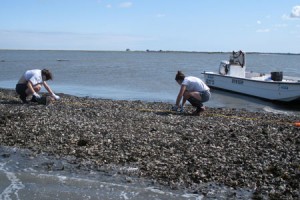
Smithsonian researchers Lori Davias and Jenna Malek collect oysters on an intertidal reef in the Chesapeake Bay. It is difficult to predict the effect of climate change on oyster populations because increasing temperatures will likely have at least two opposing effects. On one hand, intertidal oyster populations may be able to expand northward as winter temperatures rise. On the other hand, increasing summer temperatures are likely to worsen the problem of low oxygen concentrations and may reduce the extent or suitability of some subtidal habitat currently used by oysters. At this point, scientists are unable to predict whether the combination of these two factors will result in a net increase or net loss of habitat. Photo: Sean Fate
Using forecasts of atmospheric carbon dioxide production for the coming century, the scientists predict the water of the Bay will see rising levels of dissolved carbon dioxide and higher water temperatures. As a result, climate change is expected to worsen problems of low dissolved oxygen concentrations in the Chesapeake’s water and cause sea levels to rise.
For fish and other organisms living in the Bay, the scientists predict:
- Populations of marine fish that favor warmer water and whose northern range ends near the Chesapeake can be expected to increase. These include southern flounder, cobia, Spanish mackerel, mullet, tarpon, black drum, red drum, spotted sea trout, spot and Southern kingfish.
- Many fish species that favor cold water will disappear or become less abundant in the Chesapeake Bay, including soft clams, yellow perch, white perch, striped bass, black sea bass, tautog, summer and winter flounder and scup.
- Fish susceptible to winter die-offs due to the seasonal cold weather of the Chesapeake may see a strengthening of their populations due to warmer water, with more juveniles surviving through the winter.
- Warmer water also may result in longer growing seasons for fish, resulting in increased yield by some commercial fisheries. Lack of surface freezing in shoreline habitats could improve opportunities for oysters and other intertidal species to colonize shorelines.
- Some fish parasites also will likely benefit from warmer water, increasing their impact on fish and oysters in the bay.
- Rising sea levels will submerge some of the Bay’s wetlands, which many ecologically and economically important fish use as nursery areas and as foraging grounds. Degradation of these habitats could affect the larger ecosystem of the Northeast U.S. continental shelf, as many of these species spend their lives in the coastal Atlantic.
- An increase of carbon dioxide in the water of the Chesapeake may raise the acidity of the Bay and gradually reduce the ability of oysters, clams, mussels and other animals to build calcium carbonate shells.
With warming temperatures, “the species that make up the food web of the Chesapeake Bay will be impacted differently, likely disrupting the normal predator prey interactions between these animals,” says Denise Breitburg, a scientist at the Smithsonian Environmental Research Center in Edgewater, Md. Hypoxia, or a lack of oxygen in the water, will be one prevailing characteristic of warmer Bay water, Breitburg predicts. “At warmer temperatures microbes will consume oxygen at a higher rate and less oxygen can dissolve in warm water. At the same time fish and perhaps other animals, will require more oxygen in warmer water.” With these factors in mind, “we would expect more severe episodes and negative effects of low oxygen in the Chesapeake,” Breitburg says.
— By John Barrat, for Smithsonianscience.org

